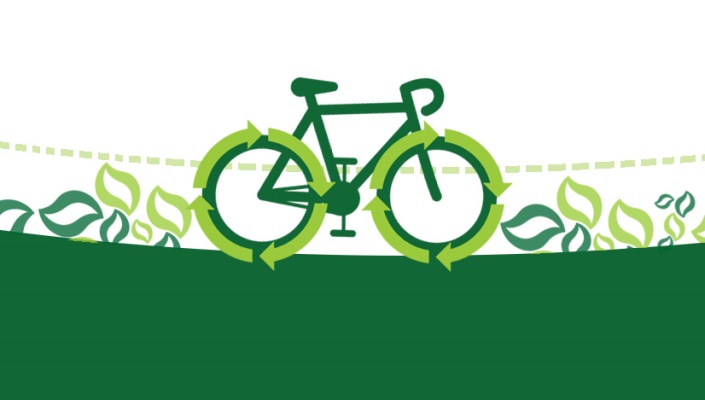Many of us know that the humble bicycle is a great way to get to and from work – especially for the urban dwellers among us. And the statistics of the trips people take are sobering. “Half of all trips are three miles or less, but fewer than 2 percent of those trips are made by bicycle, while 72 percent of them are driven. Private vehicles like cars, pick-up trucks, and SUVs, account for 60 percent of trips of a mile or less [source].”
It seems silly to drive for such short trips when a bicycle may actually be faster (and certainly cheaper). In the interest of living a “greener” lifestyle, the use of a bike for day to day tasks relates to some other eco-friendly choices we can make in our lives. Read along and learn all about them!
First, a few words about the bikes themselves: a bike is quite capable of being a “beast of burden”, and it really doesn’t take much in the way of specialized equipment to get more utility out of your two-wheeled ride. For many bikes, adding an inexpensive rear rack and some container for hauling cargo is all it takes. Those racks could take fancy panniers or a simple wire basket. I’ve even seen a milk crate lashed to the back to haul groceries! For the front, a newspaper-boy style or wicker basket is incredibly useful, but not necessary.
Don’t have a bike you’d want to use for errands? BUILD one! What better way to be green than to recycle an old and unused bike into a load-hauling machine? As long as the bike itself is sound, getting it ready for its new life as an errand-runner is cheap – maybe some new tires and tubes, some oil on the chain, installing the rear rack and/or baskets and off you go! We’ll post an article with more details on resurrecting an old bike at a later date.
Relying on a bicycle for your day-to-day transportation forces you to consider your shopping behaviors. Due to cargo capacity, it’s easy to fill up your car’s trunk with a weeks’ worth of groceries. Not so with a bike – you might get a few days’ worth, at best. Luckily, this isn’t necessarily a bad thing. There’s a real interest these days in shopping and eating locally – enjoying locally-grown foods rather than buying fruits/vegetables trucked all over the globe. Eating locally means you’re also likely to eat healthier; buying and eating fresher foods is better for you. Many cities have agricultural “co-ops” or foodshare programs. A great source of info on these programs is a site called Local Harvest. And you can bet that you’ll get extra “style points” for visiting local growers and foodshare programs by bicycle!
Other shopping errands need more planning, too – with a car, you can simply run out anytime and purchase what your heart desires, while on a bicycle, you don’t always have that flexibility. There have been many times where I simply thought to myself, “do I really need X product if I have to ride all the way across town to get it?” Thinking about spending habits also encourages you to choose your purchases wisely. My experience is that I find that I buy higher-quality items or hunt for a really killer deal, since I have to exert so much effort to make those purchases. Spending less/more wisely and consuming less is good for the soul, the environment AND the wallet.
If you’re lucky to live in a more urban environment, you might discover that there are many other errands you can run by bike. In the years that I lived car-free, I was happy to find a good dentist, a doctor for myself and my family, a post office, several grocery stores, a farmer’s market, banking, an excellent bike shop, and many other destinations within a couple miles of my house. Doing your errands locally keeps your money in your own community, and while that’s not necessarily “green”, it is good for the businesses in your area. Strong businesses mean a stronger community, and that encourages people to take better care of it.
So, you’ve begun to use your bicycle for your errands and shorter trips around your city. What if you want to go farther than you can reasonably achieve on two wheels? Two potential solutions come to mind: mass transit and car-share programs. Both of these solutions can be good for the environment, as well – reducing emissions and traffic congestion.
Many municipal bus/train services offer a means to carry a bike and rider; on the bus, the bike usually goes in a rack up front, while on a train there is often a separate bike car or a dedicated area in the passenger cars for bikes. This can be a very useful setup…multi-modal transportation means you can ride to a bus stop/train station, take the bus or train across town and still have your bike to explore the area or get your errands taken care of.
As for car-sharing programs, there is NO shame in using a car periodically if you normally rely on a bicycle for your transportation needs. Car-shares make sense because they give the user the ability to go beyond the distance of even a long bike ride, and rates are reasonable. For more information on these programs, a great resource is The Car Sharing Network.
So, these are all easy ways to incorporate two wheels into your daily lives. You can recycle (remember saving that unused bike?) save money, eat healthier, support local businesses, gain some exercise, reduce harmful pollutants and make your city a friendlier place to live. It’s really a win-win any way you look at it!
Are there any other ways you can include bikes in your daily tasks? We’d love to hear about them in the comments below.
Keeping it Green on Two Wheels
By
Jack Sweeney
| Wednesday, Jan 23, 2013



